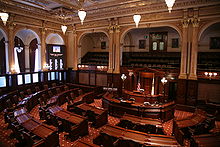
Back مجلس شيوخ إلينوي Arabic Senáu d'Illinois AST Senat d'Illinois Catalan Illinois' senat Danish Senat von Illinois German Γερουσία του Ιλινόι Greek Senado de Illinois Spanish Sénat de l'Illinois French הסנאט של אילינוי HE Senat Illinois ID
Illinois Senate | |
|---|---|
| Illinois General Assembly | |
 | |
| Type | |
| Type | |
Term limits | None |
| History | |
New session started | January 11, 2023 |
| Leadership | |
President Pro Tempore | |
Majority Leader | |
Minority Leader | |
| Structure | |
| Seats | 59 |
 | |
Political groups | Majority
Minority
|
Length of term | 4 years (with one two-year term each decade) |
| Authority | Illinois Constitution Article IV |
| Salary | $85,000/year + per diem |
| Elections | |
Last election | November 8, 2022 |
Next election | November 5, 2024 |
| Redistricting | Legislative Control |
| Meeting place | |
 | |
| State Senate Chamber Illinois State Capitol Springfield, Illinois | |
| Website | |
| Illinois Senate | |
| Rules | |
| Rules of the Senate of the 103rd General Assembly | |
The Illinois Senate is the upper chamber of the Illinois General Assembly, the legislative branch of the government of the State of Illinois in the United States. The body was created by the first state constitution adopted in 1818. Under the Illinois Constitution of 1970, the Illinois Senate is made up of 59 senators elected from individual legislative districts determined by population and redistricted every 10 years; based on the 2020 U.S. census each senator represents approximately 213,347 people.[1] Senators are divided into three groups, each group having a two-year term at a different part of the decade between censuses, with the rest of the decade being taken up by two four-year terms. For example, group one elects senators for terms of four years, four years and two years, group two elects senators for terms of four years, two years and four years, and group three elects senators for terms of two years, four years and four years.[2] This ensures that the Senate reflects changes made when the General Assembly redistricts itself after each census.
Usually, depending on the election year, roughly one-third or two-thirds of Senate seats are contested. On rare occasions (usually after a census), all Senate seats are up for election. In contrast, the Illinois House of Representatives is made up of 118 members with its entire membership elected to two-year terms. House districts are formed by dividing each Senate district in half,[3] with each senator having two "associated" representatives.
The Illinois Senate convenes at the Illinois State Capitol in Springfield, Illinois. Its first official working day is the second Wednesday of January each year. Its primary duties are to pass bills into law, approve the state budget, confirm appointments to state departments and agencies, act on federal constitutional amendments and propose constitutional amendments for Illinois. It also has the power to override gubernatorial vetoes through a three-fifths majority vote. The Illinois Senate tries impeachments made by the House of Representatives, and can convict impeached officers by a two-thirds vote.
Voting in the Illinois Senate is done by members pushing one of three buttons. Unlike most states, the Illinois Senate allows members to vote yes, no, or present. It takes 30 affirmative votes to pass legislation during final action.[4][5] The number of negative votes does not matter. Therefore, voting present has the same effect on the tally as voting no.
- ^ State Populations from U.S Census 2020 U.S Census Website
- ^ Illinois Constitution Article IV, Section 2(a) http://www.ilga.gov/commission/lrb/con4.htm
- ^ Illinois Constitution Article IV, Section 2(b) http://www.ilga.gov/commission/lrb/con4.htm
- ^ Gonzales, Nathan (February 13, 2007). "The Ever-'Present' Obama". The Rothenberg Political Report. Retrieved September 26, 2014.
- ^ Burnett, Sara (February 14, 2013). "Illinois Senate votes to legalize gay marriage". Associated Press. Retrieved September 26, 2014.